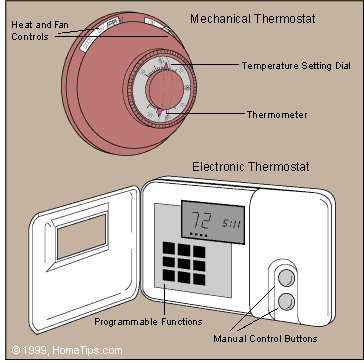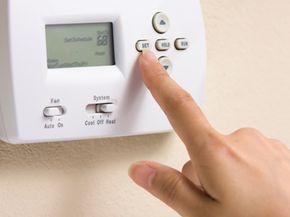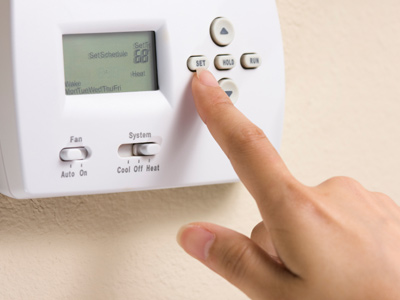Check Best Thermostat Pricing in Amazon
** As an Amazon Associate, I earn from qualifying purchases.
A home thermostat controls the temperature inside your house. It adjusts heating and cooling systems to keep you comfortable.
Understanding how a home thermostat works can help you manage your energy use and save money. This small device is crucial for maintaining a cozy home environment. It senses the room temperature and tells your heating or cooling system when to turn on or off.
Most modern thermostats offer programmable settings, allowing you to set different temperatures for various times of the day. By learning how your thermostat operates, you can optimize its settings to match your lifestyle. This guide will explain the basic functions and features of home thermostats, making it easier for you to use them effectively.
- Introduction To Home Thermostats
- Basic Components
- Types Of Thermostats
- How Thermostats Measure Temperature
- Mechanics Of Temperature Regulation
- Programming And Settings
- Integration With Hvac Systems
- Smart Thermostat Features
- Troubleshooting Common Issues
- Future Trends
- Frequently Asked Questions
- Conclusion
Introduction To Home Thermostats
Have you ever wondered how your home thermostat actually works? It’s more than just a device that lets you adjust the temperature. Understanding it can give you better control over your home’s comfort and energy efficiency. Let’s dive into the basics of home thermostats.
Purpose And Importance
The primary purpose of a home thermostat is to regulate the temperature in your living space. It ensures that your home stays at a comfortable temperature throughout the day and night. This means you won’t have to wake up shivering in the middle of the night or return to a boiling hot house after a day out.
Thermostats are also essential for energy efficiency. By setting your thermostat to the optimal temperature, you can save a significant amount on your energy bills. Did you know that adjusting your thermostat by just one degree can save up to 10% on your heating and cooling costs? That’s a small change with a big impact!
Brief History
Thermostats have come a long way since their inception. The earliest models were simple mercury thermometers with a switch. These early devices were manual and required you to adjust the temperature settings by hand.
Fast forward to today, and we have smart thermostats that can learn your preferences and adjust the temperature automatically. These modern devices can be controlled remotely via your smartphone, making it easier to manage your home’s climate even when you’re not there.
Remember when you had to get up to change the temperature? Now, you can do it from the comfort of your bed! Technology has truly transformed the way we interact with our home environments.
Have you ever thought about the convenience and efficiency a modern thermostat brings to your life? It’s fascinating to see how something as simple as a temperature control device can make a significant difference in our daily comfort and energy usage.
How do you make the most out of your thermostat? Feel free to share your tips and experiences in the comments below!
Basic Components
Understanding the basic components of a home thermostat can give you more control over your heating and cooling system. These key parts work together to ensure your home stays comfortable. Let’s break down the main components: the sensor, the control unit, and the user interface.
Sensor
The sensor is like the thermostat’s eyes and ears. It detects the current temperature in your home. If your living room feels cozy, you can thank the sensor for relaying that information.
Imagine it’s a cold winter morning. You wake up, and your feet hit the cold floor. The sensor catches that drop in temperature and sends a signal to the control unit. It’s the first step in warming up your home.
Control Unit
The control unit is the brain of the thermostat. It processes the data from the sensor and decides what to do next. If the sensor tells the control unit it’s too cold, it will activate the heating system.
Think of the control unit as your thermostat’s decision-maker. It turns your heating or cooling systems on and off based on the sensor’s readings. This process ensures your home maintains a steady, comfortable temperature.
User Interface
The user interface is what you interact with. It’s the part with the screen, buttons, or dial. This is where you set your preferred temperature.
Have you ever adjusted your thermostat before leaving for vacation? You use the user interface to make those changes. It’s simple and intuitive, allowing you to control your home’s environment with ease.
So, the next time you adjust your thermostat, remember: the sensor, control unit, and user interface are working together. They ensure your home is just the right temperature. How will you use this knowledge to keep your home comfortable?
Types Of Thermostats
When it comes to understanding how a home thermostat works, it’s essential to know the different types of thermostats available. These devices have evolved significantly over the years, offering various features and functionalities to keep your home at the perfect temperature. Let’s dive into the three main types: Mechanical, Digital, and Smart Thermostats.
Mechanical Thermostats
Mechanical thermostats are the most traditional type. They operate using physical components like mercury or metal strips to control the temperature. You usually turn a dial to set your desired temperature.
Although they are straightforward and reliable, they lack the precision of modern thermostats. If you’ve ever stayed in an older home, you might have noticed the temperature isn’t always consistent. That’s a common quirk of mechanical thermostats.
They are best suited for those who prefer simplicity and don’t need the extra features offered by digital or smart thermostats.
Digital Thermostats
Digital thermostats bring more accuracy and flexibility to your home temperature control. They use electronic sensors to maintain the desired temperature more precisely.
You can set the temperature using a digital display, making it easier to read and adjust. Some models even offer programmable settings, allowing you to set different temperatures for different times of the day.
Imagine coming home from work to a house that’s already at the perfect temperature. With a programmable digital thermostat, that’s not just a dream but a reality.
Smart Thermostats
Smart thermostats are the latest advancement in home temperature control. They connect to your home Wi-Fi network, allowing you to control the temperature from your smartphone, even when you’re not at home.
These thermostats learn your habits over time, adjusting the temperature automatically based on your preferences. They can even detect when you’re away and switch to an energy-saving mode, which can help lower your energy bills.
Some smart thermostats integrate with other smart home devices. Imagine telling your virtual assistant to lower the temperature without lifting a finger. That’s the convenience smart thermostats offer.
So, which type of thermostat suits your lifestyle? Whether you prefer the no-fuss approach of a mechanical thermostat or the high-tech features of a smart thermostat, there’s an option out there for you. What matters most is finding the one that fits your needs and keeps your home comfortable all year round.

Credit: www.hometips.com
How Thermostats Measure Temperature
Ever wondered how your home thermostat knows when to turn the heat on or off? The secret lies in its ability to measure temperature accurately. Understanding this can help you appreciate the technology that keeps your home cozy.
Let’s dive into the key components that make this possible.
Thermocouples
Thermocouples are one of the most common sensors used in thermostats. They work by producing a voltage based on the temperature difference between two different metals.
Imagine you have two different metals joined at one end. When this junction experiences a change in temperature, it generates a tiny voltage. Your thermostat then reads this voltage to determine the current temperature.
Thermocouples are reliable and durable. They can operate in a wide range of temperatures, making them ideal for various home environments.
Thermistors
Another popular sensor is the thermistor. Thermistors are special resistors that change their resistance with temperature.
Unlike thermocouples, thermistors are usually made from ceramic materials. When the temperature changes, the resistance of the thermistor changes as well. Your thermostat measures this resistance to gauge the temperature.
Check Best Thermostat Pricing in Amazon
** As an Amazon Associate, I earn from qualifying purchases.
Thermistors are known for their accuracy. They are often used in digital thermostats for precise temperature control. This ensures that your home stays at the perfect temperature, no matter the season.
So, next time you adjust your thermostat, you’ll know the intricate science behind its operation. Isn’t it fascinating how such small components make a big difference in your comfort?
Mechanics Of Temperature Regulation
Understanding the mechanics of temperature regulation in a home thermostat can save you both money and energy. This small device plays a crucial role in maintaining your home’s comfort. Let’s dive into how it regulates temperature through its fascinating components.
Heat Anticipator
The heat anticipator is a hidden gem inside your thermostat. It fine-tunes the heating system by predicting when to turn off the heater. This ensures that your home doesn’t get too warm.
Imagine you set your thermostat to 70 degrees. Without a heat anticipator, the heater would keep running until the temperature hits exactly 70. By the time it stops, your home might already feel like 72 degrees. The heat anticipator prevents this by shutting the heater off slightly earlier, considering the residual heat that will warm up your space to the desired temperature.
Cooling Mechanism
The cooling mechanism in your thermostat works similarly but in reverse. It tells your air conditioner when to start and stop. This keeps your home comfortably cool.
For instance, you set your thermostat to 75 degrees during summer. The cooling mechanism will activate the air conditioner before the temperature goes above 75. It will also shut it off slightly before reaching that point, anticipating the cool air that will continue to flow.
Have you ever noticed how your room feels just right, even when the thermostat setting seems low? That’s the magic of the cooling mechanism doing its job efficiently.
So, next time you adjust your thermostat, think about these tiny but significant components working tirelessly to keep your home cozy. How do you think understanding these mechanisms could help you use your thermostat more efficiently?

Credit: www.explainthatstuff.com
Programming And Settings
Understanding how to program your home thermostat can save energy and money. It allows you to maintain a comfortable temperature at all times. Let’s dive into the essential settings and programming options.
Setting Temperature Schedules
Setting temperature schedules can optimize your home’s heating and cooling. You can set different temperatures for different times of the day. For example, you might want it cooler at night for better sleep. During the day, a warmer setting might be more comfortable.
Most thermostats allow you to set weekday and weekend schedules. This means you can customize your comfort based on your daily routine. It’s a simple way to ensure your home is always at the ideal temperature.
Manual Vs. Programmable
Manual thermostats require you to adjust the temperature settings yourself. This can be less convenient but offers straightforward control. Programmable thermostats, on the other hand, allow you to set schedules in advance. You can program them to change the temperature automatically.
Programmable models can help save energy by reducing heating and cooling when not needed. They are perfect for busy households. With a programmable thermostat, you won’t have to remember to adjust the temperature before leaving home. It does all the work for you.
Choosing between manual and programmable depends on your preferences. Both have their benefits and can help manage your home’s temperature efficiently.
Integration With Hvac Systems
Understanding how a home thermostat integrates with HVAC systems can save you money and keep your home comfortable. The thermostat serves as the control center for your heating and cooling systems. By maintaining the desired temperature, it ensures your home remains cozy year-round.
Heating Systems
When the temperature drops, the thermostat signals the heating system to turn on. It monitors the indoor temperature and compares it to the set point. If the temperature falls below the set point, the thermostat activates the furnace or heat pump. This warms your home to the desired temperature.
Once the home reaches the set temperature, the thermostat tells the heating system to shut off. This cycle repeats as needed, maintaining a consistent indoor climate.
Cooling Systems
During hot weather, the thermostat controls your cooling system. It measures the indoor temperature and triggers the air conditioner if the temperature exceeds the set point. The air conditioner then cools your home to the desired temperature.
When the home reaches the set temperature, the thermostat instructs the air conditioner to turn off. This helps keep your home cool and comfortable without wasting energy.
Smart Thermostat Features
Smart thermostats have changed the way we manage home temperatures. They offer many features that make heating and cooling more convenient. Let’s explore some key smart thermostat features.
Remote Control
One of the best features is remote control. You can adjust the temperature from anywhere. Use your smartphone or tablet to manage your home’s climate. Whether you are at work or on vacation, control is at your fingertips. This ensures comfort and energy savings, no matter where you are.
Energy Efficiency
Smart thermostats help save energy. They learn your schedule and adjust settings automatically. This reduces energy use when you are not home. Many models show energy reports. These reports help you understand and improve your energy habits. Saving energy means lower utility bills and a smaller carbon footprint.
Troubleshooting Common Issues
Troubleshooting common thermostat issues can save you time and frustration. Understanding how to fix problems ensures your home stays comfortable. Let’s explore some frequent issues and their solutions.
Inaccurate Readings
Inaccurate thermostat readings can cause discomfort. First, check the thermostat’s location. Ensure it’s not near heat sources or drafts. These can affect readings. Clean the thermostat regularly. Dust can interfere with sensors.
Calibrate your thermostat if needed. Refer to the manual for instructions. Replace the batteries if the display is dim. Dead batteries can cause incorrect readings.
System Not Responding
If your system isn’t responding, check the power source. Ensure the thermostat is properly connected. Inspect the circuit breaker. Reset it if necessary. Confirm that the HVAC system is turned on.
Examine the wiring inside the thermostat. Loose wires can disrupt communication. If unsure, consult a professional. Sometimes, a simple reset can fix the issue. Follow the manual to reset your thermostat.

Credit: home.howstuffworks.com
Future Trends
A home thermostat works by sensing the room’s temperature and controlling the heating or cooling system. It keeps your home comfortable by turning the system on or off. Smart thermostats offer advanced features for better energy efficiency.
As technology evolves, so do home thermostats. The future trends in thermostat technology are incredibly exciting. Imagine a world where your thermostat knows your preferences and adjusts accordingly, making your home more comfortable and energy-efficient.Ai And Machine Learning
Artificial Intelligence (AI) and Machine Learning are transforming home thermostats. Modern thermostats can now learn your behavior. They adjust settings based on your daily routines. For instance, if you leave home at 8 AM every day, the thermostat will lower the temperature automatically. This not only saves energy but also reduces your utility bills. Have you noticed how your smart thermostat adapts to your schedule? It’s all thanks to AI.Enhanced Connectivity
Enhanced connectivity is another game-changer. Smart thermostats can now connect with other smart devices in your home. This seamless integration allows for a more synchronized and efficient home environment. Imagine your thermostat communicating with your smart blinds. When the temperature rises, the blinds close automatically to keep your home cool. You can also control your thermostat from anywhere using your smartphone. Stuck in traffic? Adjust your home’s temperature so it’s just right when you arrive. By staying up-to-date with these future trends, you ensure that your home is not only comfortable but also energy-efficient. What’s more, these advancements make managing your home environment easier and more intuitive. So, what’s stopping you from upgrading to a smart thermostat? The future is now, and it’s time to embrace it.Frequently Asked Questions
How Does The Thermostat In Your House Work?
A thermostat regulates your home’s temperature. It monitors the air and activates heating or cooling systems accordingly.
How Do I Know If My Home Thermostat Is Working?
Check if the thermostat display is on and set correctly. Ensure the temperature changes as you adjust settings. Verify heating/cooling system response.
Is 72 Too High For A Thermostat In Winter?
72 degrees Fahrenheit is a comfortable thermostat setting for winter. It balances warmth and energy efficiency.
How Does A Home Thermostat Read Temperature?
A home thermostat reads temperature using a sensor. The sensor detects the ambient air temperature. The thermostat then adjusts heating or cooling systems accordingly.
Conclusion
A home thermostat keeps your house comfortable and energy-efficient. It senses the temperature and adjusts heating or cooling. This device can be simple or smart. Smart thermostats learn your habits and save energy. Regular maintenance ensures its efficiency. Understanding your thermostat helps you manage your home’s climate better.
With this knowledge, you can enjoy a cozy home and lower energy bills.
Check Best Thermostat Pricing in Amazon
** As an Amazon Associate, I earn from qualifying purchases.


